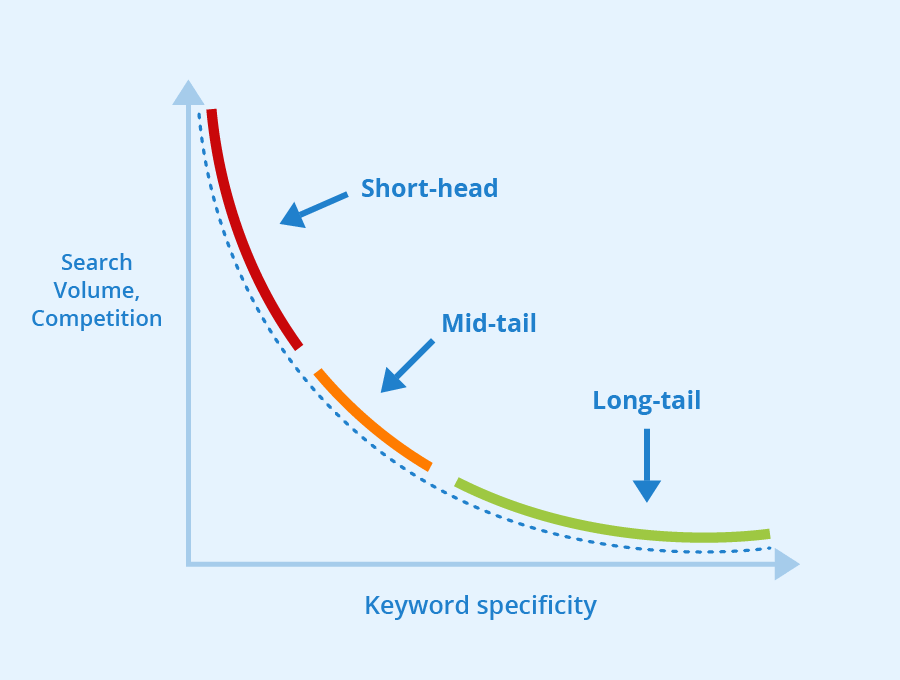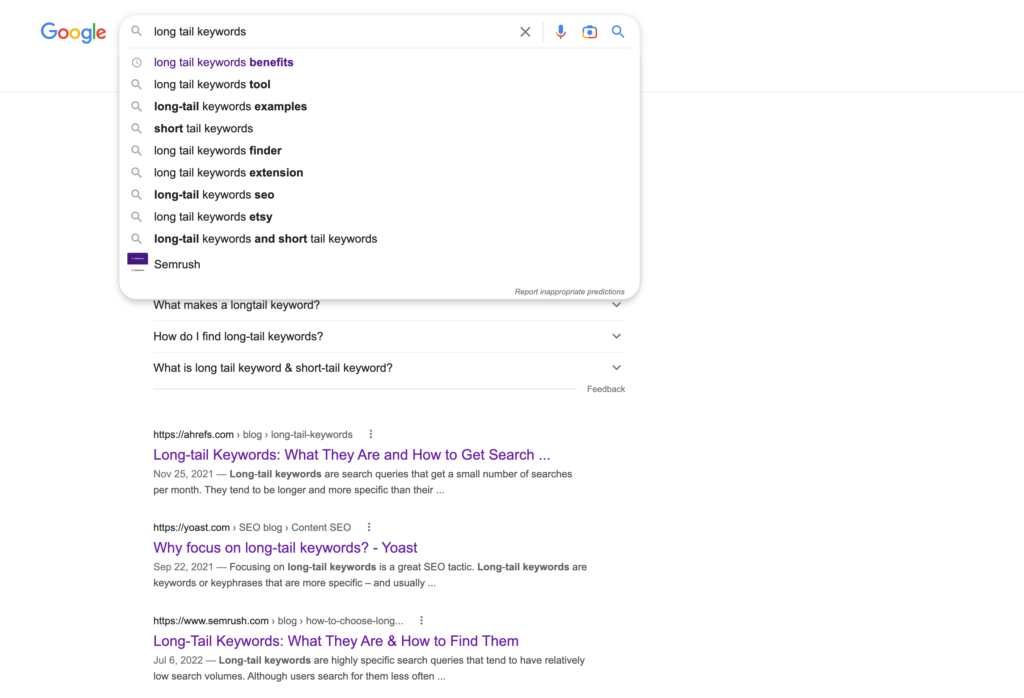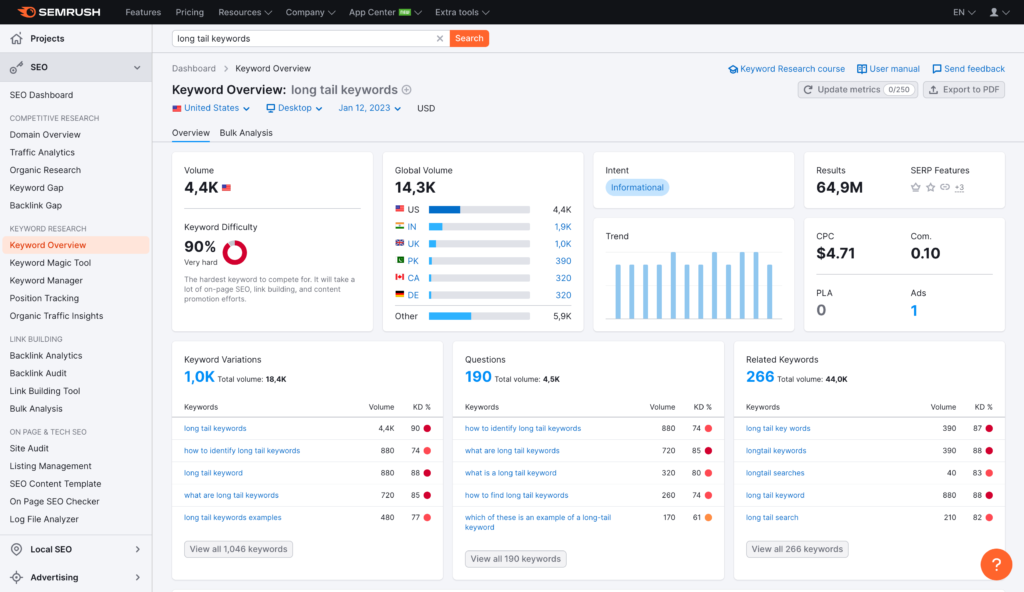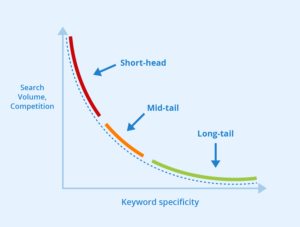
Ranking a site for common keywords is tough. Especially if your site is relatively new and the business niche is highly competitive. So if you want to increase your traffic and conversion rate, long-tail keywords are a great way to do it.
Do you want to increase the number of relevant visitors to your website? If so, your SEO approach could benefit from including long-tail keywords. But what are long-tail keywords, and why are they useful?
In this article, we’ll look at what long-tail keywords are, why they’re useful, and how you can utilize them to increase traffic and exposure for your website. You’ll have a clearer knowledge of how long-tail keywords may support your new website SEO strategy efforts by the conclusion of this article.
What are long tail keywords in SEO?
Long tail keywords are longer and more specific phrases that people use in search engines. They tend to be more targeted and less competitive than short tail keywords, which are more general and tend to have higher search volume.
Long keywords are used in SEO to refine or narrow the topic of the content being searched for. Using them can help you rank higher in search results for specific queries and drive better-quality visitors to your site.
For example, if you sell shoes online, your site might be optimized for keywords like “buy men’s shoes” or “women’s shoes for sale”. Using long keywords such as “buy men’s leather shoes” or “women’s walking shoes on sale” can help narrow the topic and make the results more relevant to the search term.
Long tail queries are often more specific and less competitive, which can make it easier for your website to rank for those terms in search engine results.
However, using long keywords can be difficult for some people and may be less effective than using shorter keywords. It also can lead to low conversions if people who find your site for those keywords don’t find what they’re looking for.
It is important to understand that using long keywords is not the only way to optimize your site for search queries. It is necessary to use a combination of different techniques and methods, such as quality content, structured data, link optimization, etc. This is why high-quality SEO blog writing comes to the fore today.

Examples of long tail keywords
Here are some long tail keywords examples:
- • “buy an inexpensive white refrigerator with a freezer”
- • “where can I find a good restaurant with a bar in the city center?”
- • “how to repair a washing machine yourself?”
- • “best organic stores in New York”
- • “what are the ways to combat hair loss at home?”
As you can see, long keywords often consist of several words and phrases that more accurately describe what people are looking for. They often include words like “buy”, “find”, “how”, “what”, “why” etc., to better understand what the user is looking for.
Long tail vs short tail keywords
The difference between short tail and long tail keywords is that long tail searches are more specific about what you offer, while short tail keywords are more general.
For example, if you sell refrigerators, then the keyword “refrigerator” is a short tail, while “buy a cheap white fridge freezer” is a long tail search term. A long tail more accurately describes what the user is looking for and can be more effective in attracting the target audience.
Essentially, the amount of specificity and level of competition between short tail and long tail keywords are what differentiates them. Long tail keyword phrases are more focused and less competitive than short tail keywords, which are more general.
However, keep in mind that using long keywords is not always the best solution. In some cases, short keywords can be more effective as they are often used in search terms. It is important to understand the specifics of your target audience and use the type of keywords you want to depend on the situation.
As noted above, long keywords are just one of many factors that search engines take into account when ranking sites. For maximum effectiveness, you should also pay attention to other elements of SEO, including the usability of the site, the presence of high authority links, backlinks, LSI keywords, etc.
Why are long tail keywords important for SEO?
Long tail phrases can be a little counterintuitive, but they are very valuable for SEO – they have traffic and low competition. Even a very high-frequency commercial phrase can be broken (most often) into a key with a tail.
Strategic use of long-tail keywords in SEO can help improve your site’s visibility in search engines and increase traffic to your site. But long keywords must be natural and relevant in order for them to be effective. Use them wisely to improve the promotion of your site in search engines and attract your target audience.
Can be said that target long-tail keywords are an important part of a well-rounded SEO strategy because they allow you to target a specific, engaged audience and drive qualified long tail traffic to your website. Our SEO agency is ready to help you build a successful strategy that takes into account all important aspects, including long-tail keywords, backlinks, copywriting, and much more.
Benefits of using long tail keywords
Much is known about the importance of keywords in general. Here are some long tail keywords benefits:
- • They can be more targeted: Long tail focus keywords are more specific, which means they can be more targeted and relevant to the content on your website or the product or service that you are offering. This can be especially useful if you have a niche product or service, as it will help you attract a more qualified audience.
- • They can be less competitive: Because long tail SEO keywords are more specific, they are often less competitive than short tail keywords. This means that it can be easier to rank for long tail keywords, and you may see more success in terms of search engine traffic.
- • They can be more cost-effective: If you are using pay-per-click advertising, targeting long tail keywords can be more cost-effective because they tend to have a lower cost per click.
- • They can help you attract a more qualified audience: By using long tail keywords, you can attract an audience that is more likely to be interested in your product or service, which can lead to higher conversion rates.
- • They can improve the user experience: By using long tail keywords, you can create content that is more relevant and useful for your audience. This can improve the user experience on your website, which can help you build a loyal following and improve your search engine rankings.
If summing up, using long tail keywords can help you create more relevant content for SEO and for your target audience, which can lead to higher conversions and better positions for your site in search results. Search engines often take into account the context and relevance of keywords, so using long tail keywords strategy can help improve a site’s SEO performance.

How to find long tail keywords
If you don’t know how to find long tail keywords for SEO, there are several ways to do it:
- 1. Use keyword research tools such as Google AdWords Keyword Planner or Ahrefs. These tools allow you to enter your main keyword and get a list of related phrases.
- 2. Use long tail keyword generators (ex. Ubersuggest, Keywordtool.io.) that can generate long tail keywords ideas for you based on a seed keyword.
- 3. Use Google autocomplete. When you enter a query into the Google search bar, you can see suggested auto-filled phrases. They can be a good source of long tail keywords, as they are based on the most popular searches being conducted by users.
- 4. Analyze competitor websites and their meta tags. Looking at a competitor’s site top pages and meta tags can give you ideas about what keywords they use and what phrases they can use to optimize their site.
- 5. Use forums and online communities to find out what questions and concerns people have about your topic. This can help you find more specific keywords that will be relevant to your audience.
- 6. Use online survey services to find out what interests your audience. This can help you find new keywords that can be helpful in optimizing your site.
In general, the key to finding long tail keywords for SEO is to be as specific as possible and think about the types of searches your target audience might be doing. By doing this, you can identify keywords that are more targeted and relevant to your business or website.
Best long tail keyword research tools
There are several tools that you can use for long-tail keyword research. Some popular options to find the best long tail keywords include:
- • Google’s Keyword Planner: This is a free long tail keywords tool that is included with a Google Ads account. It allows you to enter a seed keyword and see a list of related long-tail keywords, as well as their search volume and cost-per-click (CPC) data.
- • Ahrefs: This is a paid tool that offers a variety of SEO-related features, including long tail keyword research. It has a large database of keywords and allows you to see the search volume, CPC, and ranking difficulty for each keyword.
- • SEMrush: This is another paid tool that offers a range of SEO features, including long tail keyword research. It has a large database of keywords and allows you to see the search volume, CPC, and competition level for each keyword.
- • Keywordtool.io: This is a free tool that allows you to generate a list of search long tail keywords based on a seed keyword. It also shows the search volume and CPC data for each keyword.
- • KWFinder: This is a paid tool that offers long tail keyword research as well as other SEO features. It has a large database of keywords and allows you to see the search volume, CPC, and keyword difficulty for each keyword.
All of these tools will help you find long tail keywords as well as provide additional information such as traffic metrics, competition levels, and search volumes. It’s a good idea to use a combination of long tail keywords tools to get a well-rounded view of the long-tail keyword landscape.

How to use long tail keywords
Long tail keywords can be used to improve your site’s ranking in search engines and increase the quality of your traffic.
Some ways to use long tail keywords:
- • Create the content on your website that answers questions or addresses the needs of users related to your long tail keywords.
- • Use long tail phrases in headlines, meta titles and descriptions, and image alt tags.
- • Create pages on your website that align with your long tail keywords.
- • Use long tail phrases in the titles and descriptions of video and audio content on your site.
- • Use long tail phrases as anchor text in links that lead to your site.
- • Use long tail phrases in guest blogs, social media, and other content you publish outside of your website.
Continuing the theme of using long tail keywords terms, we would like to mention a few additional tips:
- • Create unique and relevant content that matches long tail keywords.
- • Try to use long-tail keywords in a natural way to avoid spamming and sounding stilted.
- • Don’t forget about semantics: use synonyms and similar phrases to give your content variety.
However, it is not recommended to overuse keywords and not use them in an unnatural way, because this can lead to a decrease in the quality of the content and harm the reputation of your site in the eyes of search engines.
Final thoughts on long tail SEO strategy
In conclusion, a long-tail SEO strategy can be a highly effective way to drive qualified traffic to your website and increase conversions. By targeting specific, detailed keywords in your content, PPC campaigns, meta tags and descriptions, and social media posts, you can reach an engaged audience that is searching for specific information.
To implement a successful long-tail SEO strategy, it’s important to focus on creating high-quality, valuable content that meets the needs of your audience. If you’re having trouble with this or simply don’t have the time, you may want to consider working with an experienced SEO content writing team.
At Mellow Promo, we offer professional SEO content writing services to help you improve your website’s search engine rankings and attract more qualified traffic. Our team of experienced writers and SEO experts can create engaging, targeted content that aligns with your business goals and resonates with your audience. Contact us today to learn more about how we can help you succeed with your long-tail SEO strategy.





